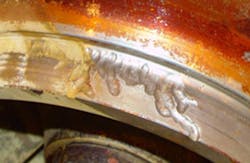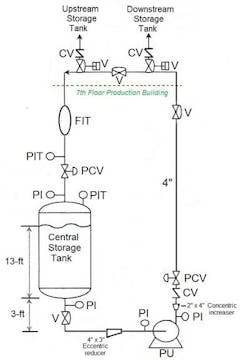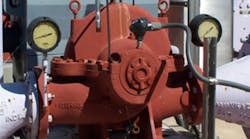(a.k.a. "The Pump Guy")
In an earlier Pump Guy article for Flow Control (July 2012) , I rhetorically asked, “Why does pump cavitation persist in the process industry? Why isn’t pump cavitation eradicated like a preventable disease? And so it goes …
Hi Larry,
At some point, I hope to attend one of your seminars. I am a process engineer in a several-hundred-million-dollar pharmaceutical plant. I have pump cavitation and excessive vibration issues that need to be resolved.
The application is on our sterile water storage and distribution system. The water is maintained at 175 F to 185 F. The recirculation and distribution pumps have suffered cavitation and vibrations since the system start-up in 2009.
At first we restricted some control valves to reduce water usage and fill rates. This reduced the noise to “tolerable” levels. But now production is increasing. We need more flow. Those valves are open. We get more cavitation damage, noise, and maintenance with the flow.
I need to first convince myself that any proposed system changes will permanently resolve the pump cavitation and excessive vibration/noise issue before I request the system downtime from our site management to implement those changes. I’m just not quite there yet. Any insight you could provide would be greatly appreciated.
Regards,
Jim H.
Process Engineer, Facilities Engineering
Hello Jim,
I appreciate your candor. Let me use your own words to help you convince yourself, and your company management, to alter the pipe system and deal with cavitation.
In your email to me, you said the cavitation was present when your pharmaceutical plant was new at system start-up back in 2009. This is evidence the problem lies in system design. It also means the solution lies in altering that system design.
Design engineers do all possible to assure adequate energy arrives into the pump suction nozzle. The engineer specifies the suction pipe diameter, pipe length, suction elbows, valves, fittings, and instrumentation so that proper energy reaches the pump at the pump’s proposed duty (head and flow) coordinates.
However, the engineer’s math regarding liquid velocity, temperature, viscosity, pipe schedules, pipe diameters, multipliers, friction tables, etc., is more “guesstimation” than calculation. Plus, the design engineer’s best intentions are interpreted and even altered by third parties (suppliers, pipe fitters, production engineers, etc.). And frequently, the pump doesn’t operate at the proposed duty coordinates. So, cavitation happens.
True cavitation originates in the suction side of the pump.
Maybe the pump is operated too far to the right of best efficiency on the performance curve where flow (GPM) is above design flow. As flow increases, more energy is required on the suction side. (As you drive your car faster, the engine requires more fuel and consumes fuel faster.)
Sometimes the design engineer’s intentions are altered. Maybe the suction pipe arrangement (elbows, valves, filters, etc.) robs more energy than calculated (guesstimated) from the liquid. Maybe inadequate energy arrives into the suction nozzle of the pump at design flow.
As you can see from these examples, the problem can be an operations problem. Or, the problem can be a design problem. In both cases, the pump is starved of energy on the suction side.
In your message to me, you said the cavitation noise calmed down when you restricted some control valves to reduce flow in the early days. In essence, your actions brought the pump’s discharge flow into line with the actual energy arriving into the pump.
You must get your pump curve. Install gauges on the pump and a flowmeter onto the pipe. Turn on the pump, and let the instrumentation tell you where and why the cavitation is occurring. If you called me to your plant to analyze the cavitation, this is what I’d do. The solution is easy once you know the problem.
You probably have the gauges and a flowmeter in your stockroom. If not, call an instrumentation supplier in your area and get some.
Some pharmaceutical applications require precise instrumentation. You described your application as heated sterile water distribution and recirculation.
I’d say you don’t need ultraprecise instrumentation for this application. After all, you’re using a centrifugal pump, and you govern flow with a valve. If you really needed precise flow and head, you’d use a positive-displacement (PD) pump in this application. Right?
The local instrumentation supplier or repair shop will have some used and reconditioned instrumentation for sale. For flow, you don’t need to know if the flow is 350 GPM or 351 GPM. You need to know if the flow is 350 GPM or 450 GPM. You don’t need to know if the differential pressure is 35 PSI or 36 PSI. You need to know if the differential pressure is 35 PSI or 45 PSI. You need instrumentation that is maybe 1 percent to 3 percent precise. Don’t buy ultra-precise instrumentation; this is “overkill.”Later,
Larry Bachus
The Pump Guy
Larry Bachus, founder of pump services firm Bachus Company Inc., is a regular contributor to Flow Control magazine. He is a pump consultant, lecturer, and inventor based in Nashville, Tenn. Mr. Bachus is a retired member of ASME and lectures in both English and Spanish. He can be reached at [email protected].





